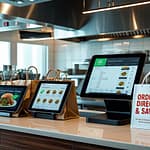Key Takeaways:
- Develop a clear, targeted social media plan tailored to your restaurant’s unique brand and customer base.
- Schedule regular, engaging posts about your menu, special offers, and events on relevant social media platforms using a marketing calendar.
- Monitor and respond promptly to customer reviews and feedback on social media to build strong relationships and improve your service.
- Utilize high-quality photos and videos of your dishes and dining experience to entice potential customers on visual platforms like Instagram.
- Track and analyze the performance of your social media activities to identify successful strategies and areas for improvement.
Your First 30 Days of Social Media Marketing: A Step-by-Step Plan
Step-by-step social strategy for new restaurants
Launching a restaurant is exciting, but getting noticed in a crowded market requires more than great food and service. Social media marketing is essential for new restaurants to build awareness, attract customers, and foster lasting relationships. If you’re unsure where to start, this comprehensive 30-day social media marketing plan will guide you step-by-step toward creating a powerful online presence.
Week 1: Lay the Foundation of Your Restaurant Social Media Plan
Day 1-2: Define Your Audience and Goals
Before you begin posting, clearly define who you’re targeting and what you want to achieve. Are you aiming to attract young professionals, families, or food enthusiasts? Identify your ideal customer demographic and set measurable goals such as follower count, engagement rates, or online reservations.
- Create audience personas detailing age, interests, and dining preferences
- Establish realistic objectives like gaining 500 followers within the first month
Day 3: Choose the Right Platforms
Not all social media platforms are created equal. Instagram and Facebook are typically most effective for restaurants, thanks to their visual appeal and broad demographic reach.
- Instagram: Ideal for sharing appealing food photos and behind-the-scenes content
- Facebook: Great for community-building, sharing specials, events, and customer reviews
Day 4-5: Optimize Your Profiles
Your social media profiles are your digital storefront. Make sure they clearly reflect your restaurant’s personality, brand, and offerings.
- Use high-quality images for profile pictures and cover photos
- Include complete contact details, location, and hours of operation
- Write concise and appealing bios that highlight unique selling points
Day 6-7: Develop a Content Calendar
A well-structured marketing calendar ensures consistency and saves valuable time. Plan your posts ahead of time to align with your business activities, promotions, and seasonal trends.
- Identify content categories: menu highlights, chef stories, guest testimonials, and special events
- Schedule posts strategically, aiming for at least 3-4 posts per week
Week 2: Create Engaging Content That Resonates
Day 8-9: Showcase Your Menu and Signature Dishes
Visual content is key to attracting diners. Professionally taken food photos and short videos showcasing your dishes will entice potential customers.
- Highlight popular dishes and chef specials
- Include vivid descriptions and attractive plating
Day 10-11: Share Your Restaurant’s Story
Customers enjoy connecting with brands on a personal level. Share the inspiration behind your restaurant, introduce your chefs and staff, and reveal behind-the-scenes moments.
- Post short video interviews with your chef or founder
- Share stories about ingredient sourcing and local partnerships
Day 12-14: Leverage User-Generated Content
User-generated content (UGC) builds authenticity and trust. Encourage diners to share their experiences on social media, and always credit and thank them when reposting.
- Create a branded hashtag and encourage customers to use it
- Regularly share customer photos, reviews, and stories
Week 3: Boost Engagement and Foster Community
Day 15-16: Interact Actively with Followers
Social media is a two-way conversation. Respond promptly to comments, messages, and reviews to build strong relationships with your audience.
- Allocate daily time to respond to comments and direct messages
- Address negative feedback professionally and publicly to demonstrate excellent customer service
Day 17-19: Run Contests and Giveaways
Contests increase visibility and encourage followers to engage actively with your content. Simple giveaways can significantly boost your follower count and brand awareness.
- Create contests that encourage tagging friends, sharing posts, or using your hashtag
- Offer appealing prizes such as free meals, gift cards, or exclusive experiences
Day 20-21: Collaborate with Local Influencers
Local influencers can introduce your restaurant to new and engaged audiences. Identify relevant food bloggers or social media personalities whose followers align with your target customers.
- Invite influencers for complimentary dining experiences in exchange for honest reviews
- Use influencer-created content to expand your reach and credibility
Week 4: Analyze, Adjust, and Expand Your Reach
Day 22-24: Evaluate Your Results
Analyzing your social media performance helps you understand what’s working and what isn’t. Use built-in platform analytics to measure engagement, follower growth, and post reach.
- Identify your most successful posts and analyze why they resonated with your audience
- Adjust your restaurant social media plan based on performance data
Day 25-27: Experiment with Paid Advertising
Boosting posts or running targeted ads can significantly increase your visibility. Even modest budgets can yield substantial returns when properly targeted.
- Experiment with small-budget Facebook and Instagram ads targeting your local area
- Promote special offers, new menu items, or upcoming events
Day 28-30: Plan for Long-term Consistency
Consistent and quality posting is crucial for sustainable growth. Use insights from your first month to refine your ongoing marketing calendar and continue building momentum.
- Set aside regular time each week to create, schedule, and analyze content
- Keep evolving your strategy based on audience feedback and market trends
Real-World Example: How One Restaurant Succeeded with Social Media
Consider “The Local Table,” a small neighborhood café that successfully leveraged social media during their opening month. By defining clear audience personas, optimizing profiles, and consistently sharing high-quality food imagery, they rapidly built a loyal following.
They encouraged customers to share their experiences using a branded hashtag, reposted customer content regularly, and actively engaged with followers. Their strategic giveaway campaigns and local influencer collaborations significantly boosted visibility. Within 30 days, The Local Table gained over 1,200 Instagram followers and saw a substantial increase in online reservations.
Conclusion
Your first 30 days of social media marketing sets the stage for long-term success. By clearly defining your audience, creating engaging content, actively interacting, and analyzing results, you establish a solid foundation for continued growth. Remember, consistency and authenticity are key—stay true to your brand voice and continually engage your audience, and you’ll see measurable results through increased visibility, customer loyalty, and ultimately, restaurant success.






Comments
Be the first to comment on this article.